La Bataille Republicaine
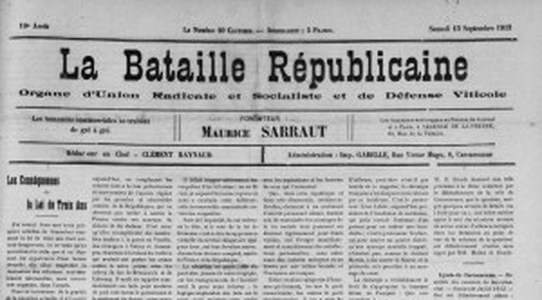
I keep up to date with the news on Johan's site and he doesnt disappoint once again. He has posted the following information;
"The researcher and librarian Xavi Bonet has published on his website an article called "... the heroic era of Rennes-les-Bains", which is a contemporary article dated 13.9.1913 written by a reporter "from" "La Bataille républicaine" newspaper. He paints a portrait of a conservative and monarchist middle class that frequent the spa at Rennes-les-Bains. There is also mention of the sympathy shown for the local "old cure" M. Boudet, who is described as 'so friendly and always willing to share his Celtic theories (or megalithic theories?)'. This "archaeologist" has indeed released a distinguished book on the subject (we are guessing True Celtic Language - 1886) and even put on the wall of his vicarage a bust of a woman larger than life (sic), saved from destruction and described as an anthropomorphic menhir. The visitor is unaware at that time that Boudet had previously been inspired to evoke a beautiful Saviour's head looking out over the valley".
You will find the original article HERE.
Xavi Bonet - who found the article - writes:
"On September 13, 1913 there was published in La Bataille Republicaine, a radical and socialist paper, an excellent article entitled "Les Bains de Rennes" which mentions many of the elements that involve the myth we now know about the whole area, Rennes-les-Bains, Rennes-le-Château ... but this time without myth, in the best pure journalistic style of a travel magazine.
[The two Rennes are] described as definitely a great place to go - giving us an inkling of the tourism framework [at the time] which included Rennes-le-Château long before the appearance of Noel Corbu, or the "Gold of Rennes" and 'Holy Blood, Holy Grail' or the " da Vinci Code". In the text we find references to places and issues well known in the mystery, the source de Magdalene, Lake Barenc, Rennes-le-Château and surprisingly fascinating ... like a tourist attraction we are invited to know the priest Henri Boudet, always ready to enlighten tourists with his knowledge.
The article talks about selling books at the gates of the hotels [which] referred to the wealth of the area which depends largely on tourism to attract people. The local response to this is why there are postcards of the famous Boudet "cromleck", why Saunière was selling postcards explaining with great enthusiasm the history of Rennes-le-Château and it's Visigoth inheritance, tourists filled the church with donations - that later served to justify the income [of Saunière?] against which there was a court sentence against him. Already in 1905, during the visit where SESA discovers for the first time the tombstone of the Marquise, those of the expedition have the option to stay and eat in a restaurant at Rennes-le-Château ... Did you know that in 1905 in Rennes-le-Château, in the waste and the construction of Villa Bethania by Sauniere, there was a restaurant that served tourists while he sold them postcards and filled the church?"
It's very interesting to read this article written by someone who was there at the time, reporting in ordinary journalistic ways about the interesting aspects of Rennes-les-Bains. It's also interesting that the two Rennes were full of tourists and in fact i'm sure somewhere i read that Sauniere made a comment about his postcards being sold at the Spa village [i'll try and locate the source of the quote]. What is interesting is that all this activity in the villages suggest that they were not really backwater villages.
I bought a copy of Jean Girou's book several years ago, where he reports the locals referring to 'treasure' as being the source of Sauniere's wealth ... then on Johans site [http://www.portail-rennes-le-chateau.com/gazette/] where i saw the article by Roger Crouquet - he talked of a desolate and empty village - essentially dying. It must have been the devastation of the War which upturned everything. The youngsters of the villages probably left as soldiers - called up for the war effort, pretty much like it happened in England. That will explain the vast difference in how the villages of the two Rennes were and what they became in 1948. It is clear that there were interesting 'things' to see and explore and explain - before and after these events. The whole of the article from 1913 is translated HERE.
The text;
This spa has waters of incomparable richness, sovereign against rheumatism, including salt waters. It is frequented by many bathers mainly from all parts of the Aude and part of Herault.
The healings obtained are incredible, and it can be said that if you do not return healed, you return relieved. The number of bathers varies between 4,000 and 5,000 each year and there are 25,000 to 30,000 baths or showers.
The Romans had already flowed the main sources and to reach them they created a path on the right bank of the Salz River, which still exists. For many years, the commune of Rennes-les-Bains has had the neighbourhood road that goes from the Pachevent bridge (over the Rialsesse), a tributary of the Salz and continues over the Bugarach (8.5 km. from Rennes), from there on Tuchan and Rivesaltes, with bifurcation in Cubières (20 km. from Rennes) on Saint-Paul de Fenouillet through the gorges of Saint-Antoine de Galamus, so justly famous.
We talked on another occasion about how to get from Carcassonne leaving in the morning to Rennes at night with Bertrand's stagecoach, it was a long trip and you had to book the place several days and when it's season, several weeks in advance. Since the creation of the Carcassonne railway in Quillan (1875), the bather stays at the Couiza-Montazels station, from where with a short walk it leads you in a short time, to get to Rennes there are still 9 km. which are covered in 2 hours.
As of today, 2 large trams pulled with 3 horses are available for travelers at Couiza station, and wonderful thing! for 1 year, a bus, a real bus at 1 franc per passenger makes the journey in half an hour! If you don't see it, you don't believe it... The inhabitants of Rennes, and the bathers too, expect the General Council to subsidise an even better bus service, it is a necessity that imposes itself.
Leaving the Couiza station, we cross the river of l'Aude. When leaving the Couiza train station, we cross the Aude River and in the same town, the Salz that we will travel to Rennes, first by the departmental road Nº 12 that goes from Chalabre to Narbonne, and through Couiza and Mouthoumet. In this part of the route, we pass looking to the left, under the village of Coustaussa dominated by the old castle, while on the right, the picturesque village of Rennes-le-Château is outlined on the top of the mountain. 5.3 km from Couiza, we take the neighbourhood road from Rennes to Bugarach crossing the Pachavent bridge at the foot of Mount Cardou with the influx of the Rialeèse stream with the Salz and constantly bordering the river. Chalabre is 32 kilometers away, Rouvenac is 15 km away, Arques is 6 km away, Mouthoumet is 23 km away, Narbonne is 79 miles away and Rennes-les-Bains is 3 miles away.
The valley becomes narrow and wooded; but at each step, huge rocks with strange shapes, reminiscent of the most beautiful Druid monuments of Brittany, rise above and down the slopes of the imposing mountains, giving this part of the route a most picturesque touch. 3 Km away. Rennes-les-Bains, (altitude of 310 meters) to which you reach after passing in front of "L'Etablissement des bains doux". At the entrance of the town, the old Hotel de la Reine, now calm and quiet, with its large garden, its bathrooms and its fountains. With Mr. Pautou's excellent cuisine much appreciated by his residents.
A few steps away, on the same side, the Hôtel Griffe, the kind of good modern family hotel, built and furnished again, not too big, maintained by a team headed by Mr. and Mrs. Griffe. Owners: Mr. Griffe, a cheerful southern French, long-time resident in London, where he was head of the Traveller's Club; Mme. Griffe, from Luxembourg and one of the great dressmakers in London.
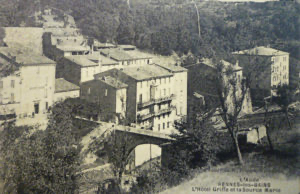 Hotel Griffe and the Fountain of Maria
Hotel Griffe and the Fountain of MariaMr. and Mrs. Griffe come every year to spend the bathing season in Rennes, and they contribute to the construction, development and maintenance of their hotel, the meticulous cleaning habits of Belgium, and the good treatment and English comfort: good food, English specialties for those who wish.
Finally, in the centre of the town, the Grand Hotel Gastilleur with its coffee and its beautiful terrace shaded by beautiful trees in front of the town square, also in the shade of magnificent banana trees. This hotel has been renovated, and is run by Mr. and Mrs. Cadenat: they maintain the perfect hotel and serve excellent food. These hotels are very well equipped, we find in them the best products in the country; from the main distillery liquors of Carcassonne, Cabanel, Vialade, Sabatier, etc., the old "Eaux-de-vie" and Marc and the Gran Crémant du Chateau des Cheminières, the various Blanquettes de Limoux, the Grands Crus de Bordeaux, Burgundy and Champagne and the main French and English liquors. The meat is excellent, the game, mushrooms and trout abound. In addition to these hotels, about thirty rustic houses, very well built, receive visitors and provide them with food and shelter as a result of the wide range of prices: each one according to their convenience finds their accommodation and their food according to their pocket and their tastes. The temperature is mild and sweet, little subject to sudden variations.
The bathrooms and showers, the effect varies depending on where you go, are administered in 4 establishments located along the Salz River. The "Bain doux" 300 meters downstream of the town. The "Bain de la Reine" on the ground floor of the Hotel de la Reine. The "Bain fort" that also includes salt water baths. The installation is primitive, and the cement bathtubs, a little narrow but the waters are so good, that they are full of bathers from morning to night. These establishments give between 20,000 and 25,000 baths or showers every year.
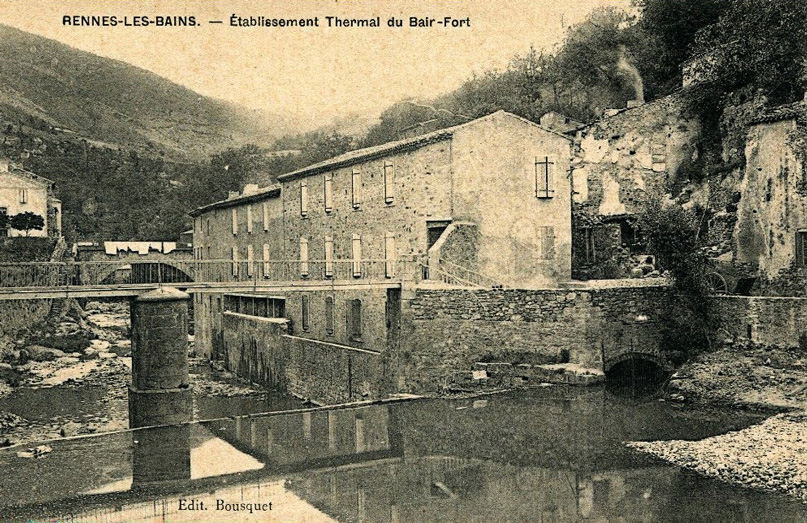
The transformation is announced below: Rennes' fortune depends on it.
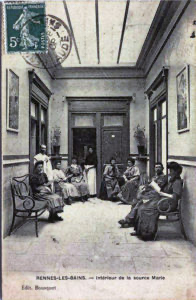
A new installation was created by Mr. Gastilleur, near the Queen's bathrooms, to capture an immediate source similar to that of the Queen: they are the "bains de Sainte Marie" in modern age with glazed bathtubs arranged in more than enough spaces, comfortable and well lit, just like the showers. By itself, this establishment provides about 6,000 annual baths or showers. All this in the three-month space that the season lasts, July, August and September. The medical profession is well represented. Dr. Roché, intelligent, strong and very active, born in the country; Dr. Servage, full of experience and great common sense; Dr. Echarnier, who comes every year from St. Paul de Fenouillet during the season (a specialized zahorí). Finally, Dr. Danjou, who gained true fame in the art of healing neurasthenia with baths, direct or underwater, massages, sunbathing or performing rhythmic and harmonic movements in the middle of a meadow or in the middle of the forest, to which he submits his patients with whom he has unlimited trust and are very deserving of it. The vegetarian diet completes the treatment.The numerous customers come from all over the place, we have more than 20 this year. Three come from Switzerland, another is a famous musician emeritus in Geneva, another is American, several live in Nice; among them, a lady of the court of England, not least, the Marquise S .., whose beauty was really impressive, and in which her ego emphasised the elegance of a profile and an unprecedented distinction.
Strangely, it lacks a pharmacist; it seems that the need is not felt, however, it is a regrettable void and will be filled next year, that if we believe the local authorities.The municipality does what it can to make life more pleasant for bathers: the electric light already illuminates the whole town, all the hotels and a large number of houses; the streets are clean, sanitary precautions are taken within the limits of the possible; but the municipal revenues are modest. The mayor Mr. Plument, a very brave and intelligent man dedicated entirely to his city, above all has the rates of each bather (Tax), which will be executed next year to make many improvements: drinking water, water treatment plants throughout the town, the maintenance of the fountains that serve as a hiking destination for bathers, etc., etc. He even hopes to gain inhabitants, who will give their homes a new and prosperous look, well finished and at least bleached periodically. If all this is done, it will have earned its small homeland and many more bathers who will frequent it.——————For those who cross Rennes without paying attention, it seems that the place lacks joy and pleasure. But it's not what it seems. The most attentive bathers or tourists find numerous elements to distract themselves.
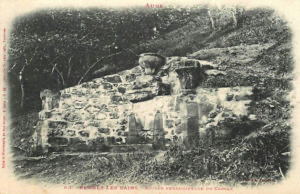
The less curious bathers have, during the visit to the various fountains where they will drink and quench their thirst, one of the elements of health such as the charming walks, numerous and very frequent. (In the same village, the source of Sainte Marie on the same road, and the Bain Fort on the north bank, on the way of arrival, on the side of Couiza), the Source de la Reine in the large garden of the hotel and the Queen's baths, at the entrance of the village; a little further at 300 meters, the Source des Bains doux, and 200 meters further, the ferruginosa source of the Poulet so called, because it is under a small bridge that crosses the route. Above the town, 800 meters away, the old ferruginous fountain "du Cercle", at the foot of a wooded mountain, and under the shade of beautiful and leafy trees that retain the strawberry at noon. Columns of ancient vestiges, show how elegance the richness of a past time. The beautiful upright that covers it, shows that at the beginning of the last century, it was still decorated with ancient art.
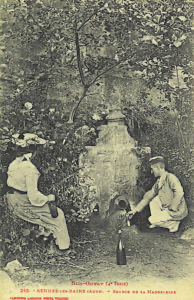
The Madeleine fountain, also very ferruginous and with small amounts of magnesia, 300 meters upstream of the Sougraigne bridge 1.5 km. from Rennes, at the foot of the mountain, to the right of the Blanque River; you arrive crossing the river by a walkway that leaves you at the foot of the rocks, under the shade of magnificent chestnut trees through a foliage that does not pass a ray of sun. To reach all these fountains, the bather constantly walks under the shelter of magnificent banana trees that shade the Rennes-Bugarach road for several more kilometers and that constitute a delicious walk even at noon.
At the end, the Fontaine d'Amour, 3 km from Rennes, following the Sougraigne road.It can be reached by the road from Rennes to Bugarach, 1.2 km from Rennes, at the confluence of the river Salz with the Blanque coming from Bugarach, past the bridge and taking the road from Rennes to Sougraigne (3.7 km from 5.2 km from Rennes), Fourtou (12.2 km. or 13.4 from Rennes), Lanet.Halfway from Sougraigne, about 3 km.Rennes, going down to the right towards the Salz River along a beautiful chestnut trail, we arrived in front of the Fontaine d'Amour (ferruginosa), in a very pleasant place, next to the river, with piles of picturesque rocks that surround it. Numerous inscriptions adorn the ancient stone walls that surround and protect the fountain where the bark of the nearby trees justifies the name of this delicious and graceful fountain.We cannot leave the Fontaine d'Amour without crossing the Salz River through the large stones that adorn the river to visit the workshop of San Oyant, the turners of the Rennes box, where the old mother sells books in front of the terrace of the Grand hotel. A charming young man full of intelligence, good will and good humour, who succeeded his father who died a long time ago, who had arrived there many years ago from St-Claude (Jura), had married in Rennes and had imported this industry. Bottle stoppers, valves, barrel tasters and pastry chefs, necessary for ladies, eggs to scramble socks, pecks, napkin rings, egg cups, salad cutlery, one wonders what this daring St-Oyant does not do with an unparalleled skill, with unbeatable prices and very moderate.
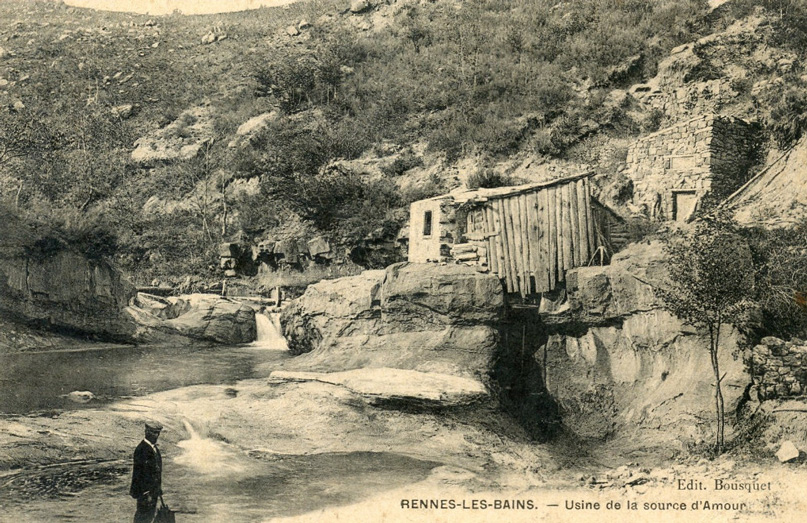
His workshop of a few square meters, on the corner of a ruined mill rebuilt with boards works with an ingenious and small turbine, arranged under a dam, composed of huge boulders taken out of the mountain all with a very picturesque touch. This walk is beautiful and would be more popular if the Sougraigne road was not so sunny. We hasten to say that this is one of the projects of the City Council of Rennes, completing the road with trees at least until the Fontaine d'Amour. This planting is expected to be carried out without delay. At least for bathers, for walkers, who do not like fatigue or very long walks. But for those who are not reluctant to walk, what great excursions are there? The Salz fountain 10 kilometers from Rennes, halfway between Sougraigne and Fourtou, beautiful and abundant source of salt water that is found in the projects of all the friends of Rennes that they plan to make once in Rennes, to receive pure salt water baths or cut by hot springs (as the waters of Salies-du-Béarn are presented and distributed in the baths of Biarritz). When you know all this, the baths of Rennes are presented with a range of possibilities unique in Europe, due to the diversity of the composition of their fountains and the origin of their specialization.
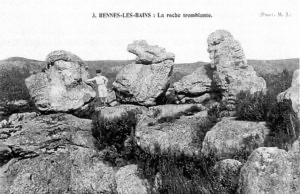
The wise Dr. Pouchet, vice president of the Public Health Council of France, the eminent man who professes pharmacodynamics in the Faculty of Medicine in Paris, that is, the study of fashion the action of various drugs, who is also part of the Mineral Waters Commission of the Academy of Medicine and the Permanent Commission of Thermal Spas, and is a regular in Rennes-les-Bains and appreciates and knows all the value and the underlying effect, and authorises us to say it. Barenc and the lagoon at the top of the mountain that dominates the hamlet of Montferrand (3.5 km) a road a little hard at times. The "trembling rock" at the top of the mountain overlooking the Fountain of the Circle. Rennes-le-Château with its old and modern buildings, a picturesque nature (2 hours walk through the mountains and the Rennes plateau). The Donjon de Arques, historical monument (9 km. Rennes.) These excursions can be easily done on foot in an afternoon. By car: the peak of Bugarach and the gorges of San Antonio de Galamus (20 Km.) With a lunch at the Hermitage or in the excellent hotels in St-Paul-de-Fenouillet. If you go by car, return through the gorges of Saint-Georges, Axat, the power plant of the Société Méridionale de Transport de Force, by the Pierre-Lys, Quillan, Ginoles baths, the baths of Campagne and Couiza (72 km.). It is undoubtedly one of the best trips we can make in the Pyrenees. We can also from Axat go up the valley through Rebenty through the famous d'Able gorges, they go up in the heights of the country of Sault by Espezel, and go down to Quillan by Belvis and Coudoms (110 km.), or through the valley of l'Aude by Husson (130 km.) until you reach Carcanières and Montlouis (200 to 250 km). Forest lovers should visit, especially in what one can walk in half a day, the top of Montferrand, the perimeter of the Rialsesse tree-lined by the Forest Administration for about 30 years and the beautiful d'Arques forests. Further on, the forests of Montaud Bézis, the Huque and the famous forest of Fanges. Those who wish to go up, make an ascent to the Cardou: (at the entrance of the Rennes valley, 3 km from Rennes, at the foot of the mountain.) Altitude 610 meters. The Bugarach peak, altitude of 1,200 meters (from Rennes to the foot of the Bugarach peak 8.5 km). Chateau Buc is outlined on the high and steep ridge of the mountain, at the foot of which a road winds from Rennes to Bugarach. In addition to the whole very picturesque line with its sawtooth, the mountain of the Capuchins and its extension on the left bank of the Bugarach river. For lovers of geology, and the search for fossils, the soil is surprisingly rich. The Cornes mountain, above the houses of the town of Rennes, on the right bank of the Salz. The fields and lands that reach the village of Sougraigne (on the church side) are full of fossil shells of bivalves (clams and others), Ammonites and sea urchins of any size and even remains of shells and legs of fossilised crustaceans. Finally, lovers of prehistoric and archaeological studies will find in the Rennes valley surprising riches: Celtic axes, flint, arrowheads, etc. Many megalithic monuments, Roman remains, lamps, tiles, jugs, etc. (Mr. Griffe Padre, one of the oldest inhabitants of the area, has a showcase full of each of these types of fossils and archaeological objects that he himself collected, and is very kindly shown to all visitors.) We must not forget the old priest of Rennes, Mr. Boudet, one of those who knows how to make himself loved by all those who arrive, he is a wise archaeologist who described in a very precise volume the numerous Druid monuments of the Rennes valley and has made a study of the most enlightened and most interesting of the Celtic language that he reconstructs with a large number of elements. This is one of the kindest and most interesting men, that one can see, always willing to share his knowledge, it is the visitors who approach him. He has, in his garden, one of the best samples of Gaulish sculpture that was saved from destruction. (The nose had already been destroyed.) It is a bust of a woman, bigger than now, which has been placed again on a pedestal, on a huge stone planted on the steep and narrow ridge that gives north, the town of Rennes, on which she tilts her head and directs her gaze.
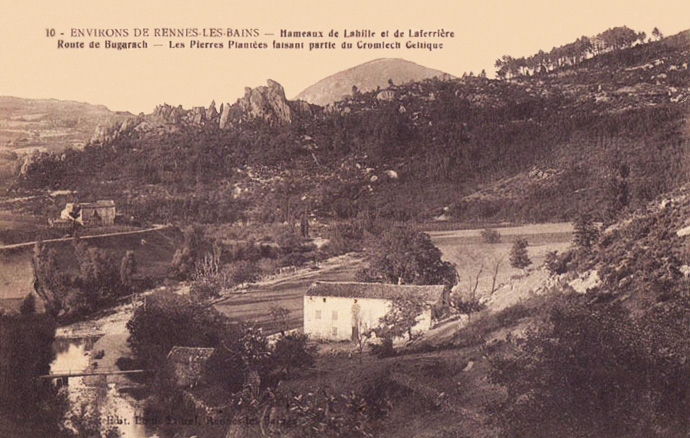
As we see, Rennes-les-Bains and its valley are not a common and uninteresting place. We can reconstitute a poor state of health; and those who wants to take the trouble, there is a lot to see, and, curiosity and love for sport help, taking the air safe that helps us safely with the thermal cures and the complete.
H.M.
P.S: The Saurer brand coaches are of the same type as the services of Luchon and Cauterets and Ax-les-Thermes, in Quillan. Its exceptional qualities of suspension and comfort have already earned the unanimous favour of tourists.
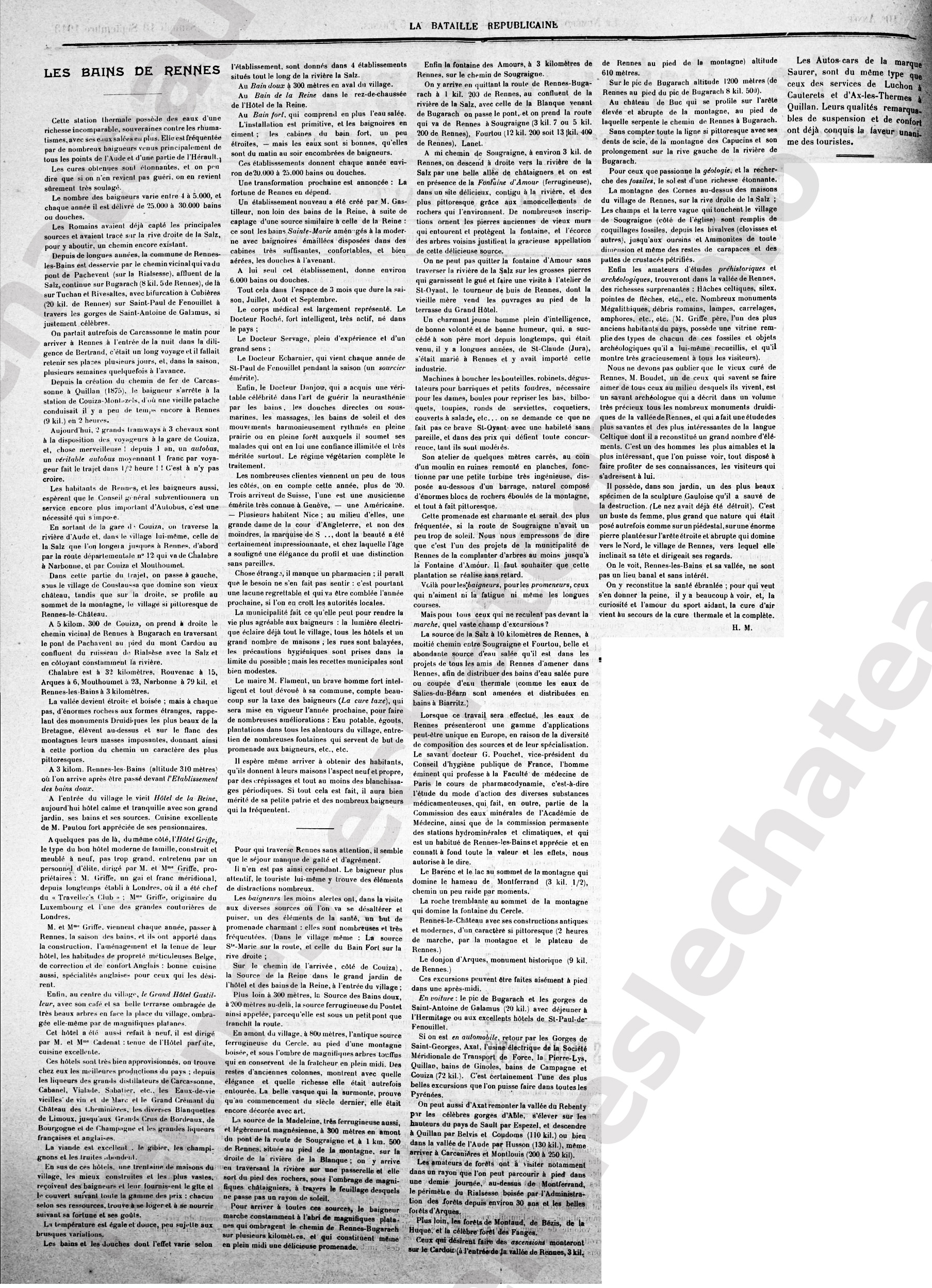
Reposted from HERE